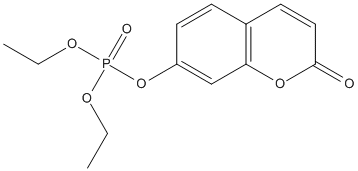DEUP
General
Type : Organophosphate || Coumarin
Chemical_Nomenclature : diethyl (2-oxochromen-7-yl) phosphate
Canonical SMILES : CCOP(=O)(OCC)OC1=CC2=C(C=C1)C=CC(=O)O2
InChI : InChI=1S\/C13H15O6P\/c1-3-16-20(15,17-4-2)19-11-7-5-10-6-8-13(14)18-12(10)9-11\/h5-9H,3-4H2,1-2H3
InChIKey : LZXQXHKDCNQUOF-UHFFFAOYSA-N
Other name(s) : diethyl 7-hydroxycoumaryl phosphate, O,O-diethyl O-(2-oxo-2H-chromen-7-yl) phosphate, CHEMBL1719220, dECP, DEUP, UBP, D7692_SIGMA, SCHEMBL404341, Diethylumbelliferyl phosphate

Target
References (6)
| Title : Conformational Disorganization within the Active Site of a Recently Evolved Organophosphate Hydrolase Limits Its Catalytic Efficiency - Mabbitt_2016_Biochemistry_55_1408 |
| Author(s) : Mabbitt PD , Correy GJ , Meirelles T , Fraser NJ , Coote ML , Jackson CJ |
| Ref : Biochemistry , 55 :1408 , 2016 |
| Abstract : Mabbitt_2016_Biochemistry_55_1408 |
| ESTHER : Mabbitt_2016_Biochemistry_55_1408 |
| PubMedSearch : Mabbitt_2016_Biochemistry_55_1408 |
| PubMedID: 26881849 |
| Gene_locus related to this paper: luccu-E3aest7 |
| Title : Organophosphate and pyrethroid hydrolase activities of mutant Esterases from the cotton bollworm Helicoverpa armigera - Li_2013_PLoS.One_8_e77685 |
| Author(s) : Li Y , Farnsworth CA , Coppin CW , Teese MG , Liu JW , Scott C , Zhang X , Russell RJ , Oakeshott JG |
| Ref : PLoS ONE , 8 :e77685 , 2013 |
| Abstract : Li_2013_PLoS.One_8_e77685 |
| ESTHER : Li_2013_PLoS.One_8_e77685 |
| PubMedSearch : Li_2013_PLoS.One_8_e77685 |
| PubMedID: 24204917 |
| Gene_locus related to this paper: helam-d5g3c9 , helam-d5g3d2 , helam-d5g3d3 , helam-d5g3d4 , helam-d5g3d5 , helam-d5kx87 , helam-d5kx99 , helam-d5kxa9 , helam-d9iv61 , helam-d9iv62 , helam-h9zvh4 , helam-s4wfz6 |
| Title : Hydrolysis of organophosphorus insecticides by in vitro modified carboxylesterase E3 from Lucilia cuprina - Heidari_2004_Insect.Biochem.Mol.Biol_34_353 |
| Author(s) : Heidari R , Devonshire AL , Campbell BE , Bell KL , Dorrian SJ , Oakeshott JG , Russell RJ |
| Ref : Insect Biochemistry & Molecular Biology , 34 :353 , 2004 |
| Abstract : Heidari_2004_Insect.Biochem.Mol.Biol_34_353 |
| ESTHER : Heidari_2004_Insect.Biochem.Mol.Biol_34_353 |
| PubMedSearch : Heidari_2004_Insect.Biochem.Mol.Biol_34_353 |
| PubMedID: 15041019 |
| Gene_locus related to this paper: luccu-E3aest7 |
| Title : Kinetic efficiency of mutant carboxylesterases implicated in organophosphate insecticide resistance - Devonshire_2003_Pestic.Biochem.Physiol_76_1 |
| Author(s) : Devonshire AL , Heidari R , Bell KL , Campbell PM , Campbell BE , Odgers WA , Oakeshott JG , Russell RJ |
| Ref : Pesticide Biochemistry and Physiology , 76 :1 , 2003 |
| Abstract : Devonshire_2003_Pestic.Biochem.Physiol_76_1 |
| ESTHER : Devonshire_2003_Pestic.Biochem.Physiol_76_1 |
| PubMedSearch : Devonshire_2003_Pestic.Biochem.Physiol_76_1 |
| PubMedID: |
| Gene_locus related to this paper: luccu-E3aest7 , musdo-EST23aes07 |
| Title : Diethylumbelliferyl phosphate inhibits steroidogenesis by interfering with a long-lived factor acting between protein kinase A activation and induction of the steroidogenic acute regulatory protein (StAR) - Choi_1995_Eur.J.Biochem_234_680 |
| Author(s) : Choi YS , Stocco DM , Freeman DA |
| Ref : European Journal of Biochemistry , 234 :680 , 1995 |
| Abstract : Choi_1995_Eur.J.Biochem_234_680 |
| ESTHER : Choi_1995_Eur.J.Biochem_234_680 |
| PubMedSearch : Choi_1995_Eur.J.Biochem_234_680 |
| PubMedID: 8536719 |
| Title : Evidence that a neutral cholesteryl ester hydrolase is responsible for the extralysosomal hydrolysis of high-density lipoprotein cholesteryl ester in rat hepatoma cells (Fu5AH) - Delamatre_1993_J.Cell.Physiol_157_164 |
| Author(s) : Delamatre JG , Carter RM , Hornick CA |
| Ref : Journal of Cellular Physiology , 157 :164 , 1993 |
| Abstract : Delamatre_1993_J.Cell.Physiol_157_164 |
| ESTHER : Delamatre_1993_J.Cell.Physiol_157_164 |
| PubMedSearch : Delamatre_1993_J.Cell.Physiol_157_164 |
| PubMedID: 8408234 |